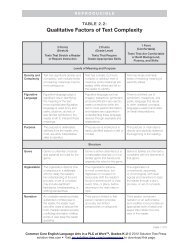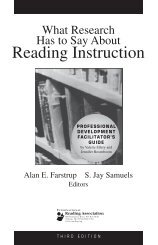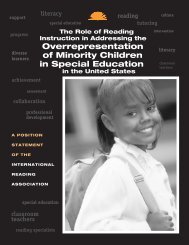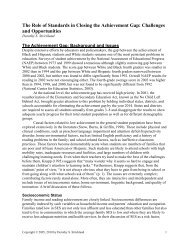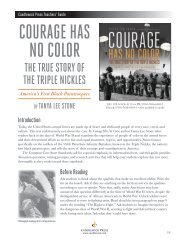Global Education Digest 2012 - International Reading Association
Global Education Digest 2012 - International Reading Association
Global Education Digest 2012 - International Reading Association
Create successful ePaper yourself
Turn your PDF publications into a flip-book with our unique Google optimized e-Paper software.
READER’S GUIDE<br />
ii) UOE survey<br />
UNESCO, the OECD and Eurostat (UOE) have jointly administered this annual data collection since 1993. The<br />
UOE questionnaire compiles data from high- and middle-income countries that are generally members or partner<br />
countries of the OECD or the European Union. The UOE survey collects more detailed education statistics and<br />
allows for the production of a wider set of indicators, as presented in Statistical Tables 16-22. The countries that<br />
participate in the UOE data collection are listed in Annex C.<br />
iii) WEI programme<br />
The World <strong>Education</strong> Indicators (WEI) programme provides a platform for middle-income countries to develop a<br />
critical mass of policy-relevant indicators beyond the global core set of education statistics. This also allows for<br />
direct comparisons with countries participating in the UOE survey as the collection of data from WEI countries is<br />
based on a same common set of definitions, instructions and methods.<br />
Participating countries in the WEI data collection are: Argentina, China, Egypt, India, Indonesia, Jamaica,<br />
Jordan, Malaysia, Paraguay, Peru, the Philippines, Sri Lanka, Thailand, Tunisia and Uruguay. The UIS hosts the<br />
secretariat for the WEI programme.<br />
Literacy<br />
All literacy data are UIS estimates unless otherwise noted.<br />
Literacy statistics for youth aged 15 to 24 years and adults aged 15 years and older are obtained from national<br />
population censuses, household surveys, and estimates using the UIS <strong>Global</strong> Age-Specific Literacy Projections<br />
Model (GALP) http://www.uis.unesco.org/publications/GALP. The UIS literacy questionnaire can be<br />
downloaded at http://www.uis.unesco.org/UISQuestionnaires/Documents/UIS_LIT_<strong>2012</strong>_EN.pdf<br />
Data sources, reference years and national definitions are available in the literacy metadata table available in the<br />
UIS Data Centre http://stats.uis.unesco.org<br />
<strong>Education</strong>al attainment<br />
Statistics on educational attainment for the population aged 25 years and older are based on national population<br />
censuses or surveys.<br />
Population<br />
Population statistics for countries with at least 50,000 inhabitants are provided by the United Nations Population<br />
Division, based on the 2010 Revision of the World Population Prospects. For more information on UN Population<br />
Division estimates, please visit http://www.un.org/esa/population/unpop.htm<br />
For countries where UN Population Division data are not available, the UIS derives estimates by single-year of<br />
age from other sources, such as Eurostat (Demographic Statistics), the Secretariat of the Pacific Community<br />
(Statistics for Development Programme) and national statistical offices.<br />
Population-based indicators are listed as missing (…) when population data are not available or not considered<br />
reliable. In exceptional cases, the UIS uses national data when enrolment data collected by the UIS and<br />
population data produced by the UN Population Division are not consistent.<br />
<strong>Education</strong> indicators based on population estimates by age and sex for countries with a total population under<br />
100,000 inhabitants should be interpreted with caution due to fluctuations in migration and other factors.<br />
78








